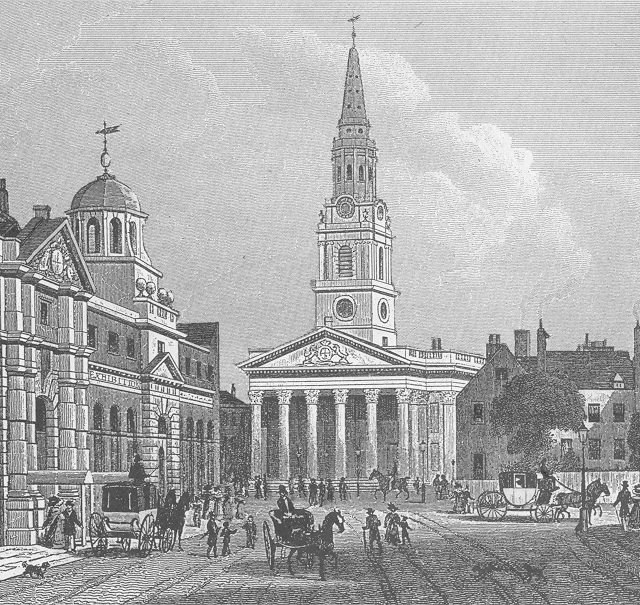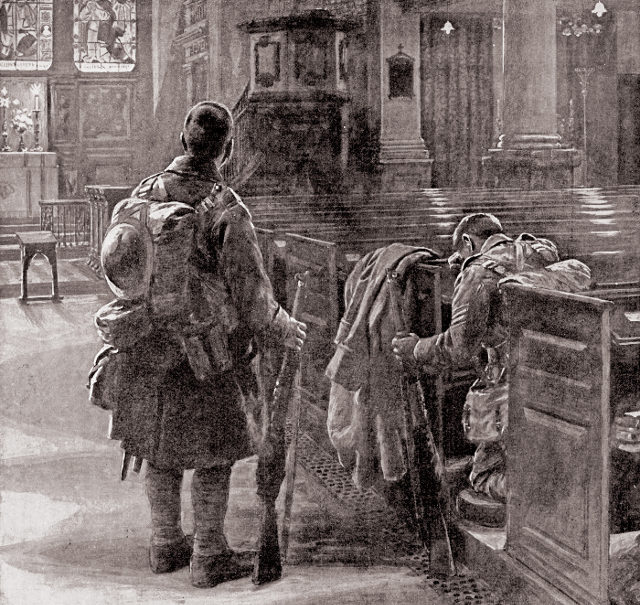Parish Archive
Records about births, deaths and marriages in the Parish of St Martin-in-the-Fields are held by the Westminster City Archive.
If you are researching your family history, then this is a great place to start.
St Martin-in-the-Fields is a landmark. Its fine architecture and prominent location place it at the heart of the nation. Its work has valued historic tradition, but St Martin’s has always been innovative in response to changing needs. From London’s first free lending library to the first religious broadcast, St Martin’s has broken new ground in defining what it means to be a church.
There is no official reference to a church on the site of St Martin’s until Norman times, when in 1222 a dispute was recorded between William, Abbot of Westminster, and Eustace, Bishop of London on the Bishop’s authority over the church. The Archbishop of Canterbury decided in favour of the abbot and St Martin’s, then surrounded by fields, appears to have been used by the monks of Westminster.
In around 1542, Henry VIII, as ruthless with the monks as with his wives, built a new church and extended the parish boundaries to keep plague victims from being carried through his palace. This was enlarged in 1607 at the cost of Prince Henry, the son of King James I. This church was pulled down in 1721 to be replaced by the current building.
The present church was designed by James Gibbs and completed in 1726. It has become one of the most significant ecclesiastical buildings in the English-speaking world. In the 19th century, whilst planning Trafalgar Square, John Nash created Church Path and the range of buildings to the north. St Martin’s has always been at the heart of London, offering continued service amidst an ever-changing city.

The work of this church today is informed by the practical Christianity exemplified in the life of its patron saint. Martin, after a career in the Roman army, entered the Christian Church and became Bishop of Tours. He is remembered for an instinctive act of generosity, sharing his cloak with a beggar. Paradoxically, the ultimate blessing was given to Martin by the beggar, who returned to him in a dream as Christ.
The example of St Martin was followed by Dick Sheppard, Vicar of St Martin’s during World War I, who gave refuge to soldiers on their way to France. He saw St Martin’s as ‘the church of the ever open door’. The doors have remained open ever since.

St Martin’s fight against homelessness was formalised with the foundation of the Social Service Unit in 1948. The work continues today through The Connection at St Martin’s, which cares for around 7,500 individuals each year.
Changing needs in society were again evident in the 1960s. St Martin’s was concerned for the welfare of new arrivals in the emerging Chinatown and welcomed a Chinese congregation. Today, the Ho Ming Wah Chinese People’s Day Centre provides vital services for the Chinese community in London.
Throughout the 20th century, St Martin’s has also looked beyond its own doors and played an active role in wider social, humanitarian and international issues. Architecturally, spiritually, culturally and socially, St Martin’s has helped to form the world around it.
Thanks to St Martin’s first biographer, Sulpicius Severus, we know a great deal about the life of this humble saint. Martin was born in AD 316 in Pannonia, today part of Hungary and was baptised at eighteen years old, rejecting the old religion adhered to by his mother and father. Reluctant to join the Roman army, he was obliged by law to take the military oath, which he then felt compelled to obey. As a soldier posted in Amiens in France, the eighteen year old Martin rode through the city gate one bitter winter’s night and saw an almost naked beggar huddled against the stonework. Martin cut his cloak in two with his sword and gave half to the beggar. That night, in a dream, Christ appeared to Martin in the form of the beggar to thank him and next day Martin rushed to be baptised.
Martin could never quite reconcile war with his Christian beliefs and eventually he gave it up to become a “soldier of Christ”. Hounded out of his hometown, he became a recluse on an island near Milan where he founded a monastery called Ligug for the disciples who came to him. It is whilst on the island that he is said to have performed the first of many miracles.
When the Bishop of Tours, France, died, the townspeople tricked Martin into visiting the town so that they could make him Bishop. On taking up the post, he insisted on living as a monk in a cell, rejecting the offer of a palace. Martin lived to be over 80 years old and through his travelling from house to house and speaking to people about God, many people found Christ. St Martin’s day is on 11 November, which is the day he was buried in the Cemetery of the Poor in Tours.
There are five books which deal with the history of the church:
St Martin-in-the-Fields by Malcolm Johnson (Phillimore & Co Ltd, 2005). This includes chapters on: the first two churches 1222-1720; present building 1720-1914; history and vicars 1914-2006; the Parish – people and places; schools; organs and organists; the bells; St Martin’s possessions; Churchwardens and lay officials; the Least the last and the lost; the Academy of St Martin in the Fields and Vicars 1275-2005. This book is available in our shop.
A Short History of the Royal Parish Church of St Martin-in-the-Fields, London by John McMaster (1915/16). John McMaster was a historian and a churchwarden of St Martin’s between 1906 and 1919.
Betwix Heaven and Charing Cross by Carolyn Scott (Robert Hale & Company, 1971) ISBN 0 7091 2158 X.
You Owe Me Five Farthings by George Fearon (Skeffington, 1961)
The Story of St Martin’s – an epic of London by Vera Brittain.
Records about births, deaths and marriages in the Parish of St Martin-in-the-Fields are held by the Westminster City Archive.
If you are researching your family history, then this is a great place to start.
If you are researching St Martin’s interior/exterior features or church activities prior to 1900, you may always wish to start with the City of Westminster Archive.
Email them with your request at archives@westminster.gov.uk
The archive is based at 10 St Ann’s Street, London SW1P 2DE
Tel: 020 7641 5180
St Martins does hold some archival information, about baptisms in church from May 1965 or weddings from December 1979.
To view these records, please email the Vergers, or call them on 020 7766 1123. You can also email archives@smitf.org with your request.
If you are researching the church or its community, then we have a collection of old Parish Magazines and other records.
We have recently started to organise these records so that they are accessible to interested parties, information will be posted here when it becomes available.